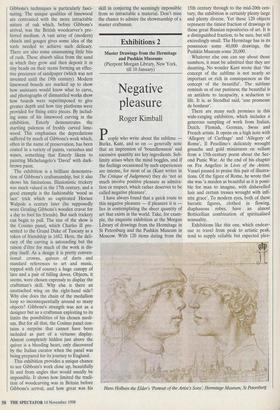Exhibitions 2
Master Drawings from the Hermitage and Pushkin Museums (Pierpont Morgan Library, New York, till 10 January)
Negative pleasure
Roger Kimball
People who write about the sublime Burke, Kant, and so on — generally note that an impression of 'boundlessness' and excessive quantity are key ingredients. Sub- limity arises when the mind boggles, and if the feelings occasioned by such experiences are intense, for most of us (Kant writes in The Critique of Judgement) they do 'not so much involve positive pleasure as admira- tion or respect, which rather deserves to be called negative pleasure'.
I have always found that a quick route to this negative pleasure — if pleasure it is lies in contemplating the sheer quantity of art that exists in the world. Take, for exam- ple, the exquisite exhibition at the Morgan Library of drawings from the Hermitage in St Petersburg and the Pushkin Museum in Moscow. With 120 items dating from the 15th century through to the mid-20th cen- tury, the exhibition is certainly plenty large and plenty diverse. Yet these 120 objects represent the tiniest fraction of drawings in those great Russian repositories of art. It is a distinguished fraction, to be sure, but still exceedingly small. The Hermitage has in its possession some 40,000 drawings, the Pushkin Museum some 20,000.
Whatever else one can say about those numbers, it must be admitted that they are daunting. No wonder Kant wrote that 'the concept of the sublime is not nearly so important or rich in consequences as the concept of the beautiful'. The sublime reminds us of our puniness; the beautiful is an antidote to incapacity, a seduction to life. It is, as Stendhal said, 'tine promesse de bonheur'.
There are many such promises in this wide-ranging exhibition, which includes a generous sampling of work from Italian, Dutch, Flemish, German, Swiss and French artists. It opens on a high note with `Allegory of Carthage' and 'Allegory of Rome', Il Pesellino's delicately wrought gouache and gold miniatures on vellum from a 15th-century poem about the Sec- ond Punic War. At the end of his chapter on Fra Angelico in Lives of the Artists, Vasari paused to praise this pair of illustra- tions. Of the figure of Rome, he wrote that she was 'a maiden as beautiful as it is possi- ble for man to imagine, with dishevelled hair and certain tresses wrought with infi- nite grace'. To modern eyes, both of these hieratic figures, clothed in flowing, diaphanous robes, have an almost Botticellian combination of spiritualised sensuality.
Exhibitions like this one, which endeav- our to travel from peak to artistic peak, tend to supply reliable but expected plea-
Hans Holbein the Elder's Portrait of the Artist's Sons, Hermitage Museum, St Petersburg sures. One is delighted but not surprised to find Il Parmigianino's 'The Virgin and Child' — a preparatory study for a major altarpiece — or Luca Penni's extraordinary pen and ink 'Contest Between Entellus the Sicilian and Dares the Trojan'. Even the breathtaking drawings — Giovanni Anto- nio Sogliani's 'Head of a Young Male Saint' — or Daniele da Volterra's deliques- cent 'Sibyl' in black chalk (formerly ascribed to the artist's friend and mentor Michelangelo) are exactly the kind of thing one expects from such an exhibition of masterpieces. It is overwhelmingly proba- ble that you have never before seen any of the drawings in this exhibition; several of the artists, too, are likely to be unfamiliar to all but connoisseurs; still, you have seen many things like the drawings on view here.
It is the same with many of the more recent drawings. David's 'Study For the Figure of a Sabine Woman' in black chalk displays an element of sudden eroticism that is unusual in the work of this champi- on of heroic virtue, but essentially it is a familiar kind of neo-classical study. And the handful of drawings by Matisse — `Slavic Blouse', 'Turkish Woman' and `Woman with Bare Breasts' are especially notable — are superb but unsurprising.
There is a lot to be said for such gratifi- cation of expected excellence. But this exhibition has its share of quiet surprises as well. Among the surprises are some draw- ings by Jean-Baptiste Greuze (1725-1805) which exhibit a penetration and hardness that one does not usually associate with this champion of feminine pinks. His 'Head of an Old Woman,' especially — a power- ful character study in red chalk — is a reve- lation of an unfamiliar, tauter and more acidulous artist than we are used to with Greuze. There is also Ruisdael's striking chalk and grey wash 'Landscape with a Wooden Footbridge', which is probably the finest finished drawing by this master of landscape that I have ever seen.
Naturally there are some disappoint- ments in this show. Or perhaps it would be more accurate to say that the works on view are so various that it is almost impos- sible that every item will appeal to any one person. I have always felt about Caspar David Friedrich the way some people (inexplicably) feel about garlic: that a little goes a long way. Somehow his lonely pil- grims gazing out over Alpine vastnesses always strike me as a kind of buffo sublime: pretentious and sentimental in a plodding, Teutonic way. Here we are spared the Alps. But 'Moonrise' (1815-17), which depicts two men gazing out over the sea at an eldritch moon, teeters on hokeyness. And `Coffm on a Grave' tumbles over the edge.
But so what? Most of the drawings on view here are exceptionally accomplished. And many are so enchanting that you will take away the experience of them as a beguiling memory.



















































































 Previous page
Previous page